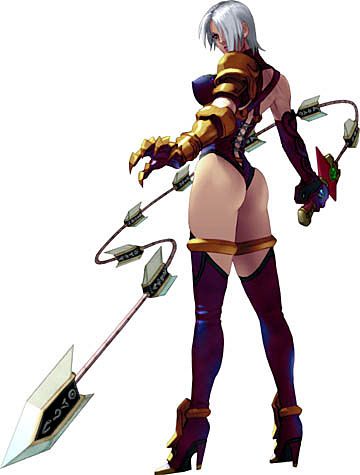
Yesterday, I gave two examples of what I consider a feminine aesthetic in video games: Prince of Persia (2008) and Silent Hill 2. Today, I’m going to clarify what I mean by a feminine aesthetic, then I’m going to give examples of what is not feminine and why it’s not feminine.
I changed the name of my series from ‘Femininity in Video Games’ to ‘The Feminine Aesthetic in Video Games’ to clarify my intent. This isn’t about how many games portray women or notions of femininity within games. It’s not about how to get more women to play games, or even how women react to games differently than men. However, those are all good ideas for posts… Give me a second while I write them down.
As I related previously, the seed for this series came about when Craig Graff of BioWare posted the Breathe Me trailer for Prince of Persia (2008). It struck me as feminine, as did the game when I played it. This series is my attempt to clarify and define what a feminine aesthetic is when it comes to video games.
Despite my use of the term feminine, I am not suggesting a system in which all games fall into a masculine or feminine divide. This is just one of many. I use the term aesthetic because I focus on stylistic choices as opposed to pure gameplay or genre elements. A first person shooter could use a feminine aesthetic, though I cannot recall any that have.
Lastly, why use the word ‘feminine’ when it comes to this aesthetic? Because I see it as a necessary counterpart to the hyper-masculine aesthetic that dominates many games. There’s nothing wrong with making a video game version of the 300, but there’s nothing write with it either.

(I considered calling this the Persian Aesthetic after the Prince of Persia games and they were the counterparts to the Spartans in 300 and Halo, but that’s too obscure and not evocative enough.)
When I say ‘feminine’ in regards to video games, a few examples might pop up in your mind. These examples might involve large amounts of pink, Barbie, or games about riding horses or vet hospitals.
No.

These are game designed, marketed, and (mostly) consumed by young girls, but ‘feminine aesthetic’ is not about what women (or girls) traditionally like. Moreover, most of these games have a very simple aesthetic at work: cute, cute, and cute. Cute isn’t feminine, it’s infantile. Puppy dogs, kittens, seal cubs, and human babies are cute no matter what their sex.
Wikipedia is never wrong.


Feminine aesthetics also has little to do with the common depiction of women in video games, which tends to play up their hotness. Bloodryne or Ivy, for example do not show a feminine aesthetic in as much as a sexualized one. One could even suggest that the imagery here is masculine in style.
There are also games with elements that may overlap with a feminine aesthetic but are from a preexisting style. Some of Japanese and Korean games, such as
Ragnarok Online are based on manga and anime, which has its own history as well as refined visual and storytelling elements. Likewise, there are Western games that borrow heavily from cartoons,
Clank and Ratchet for example.
I could continue along this vein: the Fallout series shows a post-apocalyptic aesthetic. Many science fiction games envision spaces of the future as an unholy cross between a dentist’s office, a mall, and a trailer house – the main difference between different settings is whether the dentist’s office is a clean and shiny place that you’d take your kids to or some dingy, back alley place where they use a wrench for extractions. So, we could say Halo and Mass Effect have a sci-fi aesthetic. And let’s not forget how much horror games tend to have in common.
After a post in which I explain what the feminine aesthetic is not, I feel the need to add that there’s no reason why these elements and styles can’t co-exist in the same game. While ‘cute and girly’ games are not inherently feminine, mixing in a feminine aesthetic is possible and might improve the games.
First through, I’d have to pin down what I mean by a feminine aesthetic. That's part 3.




 Feminine aesthetics also has little to do with the common depiction of women in video games, which tends to play up their hotness. Bloodryne or Ivy, for example do not show a feminine aesthetic in as much as a sexualized one. One could even suggest that the imagery here is masculine in style.
Feminine aesthetics also has little to do with the common depiction of women in video games, which tends to play up their hotness. Bloodryne or Ivy, for example do not show a feminine aesthetic in as much as a sexualized one. One could even suggest that the imagery here is masculine in style.